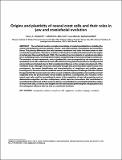Por favor, use este identificador para citar o enlazar a este item:
http://hdl.handle.net/10261/24474COMPARTIR / EXPORTAR:
 SHARE
BASE SHARE
BASE
|
|
| Visualizar otros formatos: MARC | Dublin Core | RDF | ORE | MODS | METS | DIDL | DATACITE | |

| Campo DC | Valor | Lengua/Idioma |
|---|---|---|
| dc.contributor.author | Trainor, Paul A. | - |
| dc.contributor.author | Melton, Kristin R. | - |
| dc.contributor.author | Manzanares, Miguel | - |
| dc.date.accessioned | 2010-05-19T10:30:15Z | - |
| dc.date.available | 2010-05-19T10:30:15Z | - |
| dc.date.issued | 2003 | - |
| dc.identifier.citation | International Journal of Developmental Biology 47(7-8): 541-553 (2003) | en_US |
| dc.identifier.issn | 0214-6282 | - |
| dc.identifier.uri | http://hdl.handle.net/10261/24474 | - |
| dc.description | 13 pages, 5 figures, | en_US |
| dc.description.abstract | The vertebrate head is a complex assemblage of cranial specializations, including the central and peripheral nervous systems, viscero- and neurocranium, musculature and connective tissue. The primary differences that exist between vertebrates and other chordates relate to their craniofacial organization. Therefore, evolution of the head is considered fundamental to the origins of vertebrates (Gans and Northcutt, 1983). The transition from invertebrate to vertebrate chordates was a multistep process, involving the formation and patterning of many new cell types and tissues. The evolution of early vertebrates, such as jawless fish, was accompanied by the emergence of a specialized set of cells, called neural crest cells which have long held a fascination for developmental and evolutionary biologists due to their considerable influence on the complex development of the vertebrate head. Although it has been classically thought that protochordates lacked neural crest counterparts, the recent identification and characterization of amphioxus and ascidian genes homologous to those involved in vertebrate neural crest development challenges this idea. Instead it suggests thatthe neural crest may not be a novel vertebrate cell population, but could have in fact originated from the protochordate dorsal midline epidermis. Consequently, the evolution of the neural crest cells could be reconsidered in terms of the acquisition of new cell properties such as delamination-migration and also multipotency which were key innovations that contributed to craniofacial development. In this review we discuss recent findings concerning the inductive origins of neural crest cells, as well as new insights into the mechanisms patterning this cell population and the subsequent influence this has had on craniofacial evolution. | en_US |
| dc.description.sponsorship | This work was supported by a March of Dimes Basil 0,Connor Sholar research award (P.A.T), a Childrens,s Mercy Hospital Clinical Scholarship (K.R.M) the Stowers Institute for Medical Research (P.A.T and K.R.M) and the Spanish Ministry of Science and Technology (M.M.). | en_US |
| dc.format.extent | 464184 bytes | - |
| dc.format.mimetype | application/pdf | - |
| dc.language.iso | eng | en_US |
| dc.publisher | Universidad del País Vasco | en_US |
| dc.rights | openAccess | en_US |
| dc.subject | Craniofacial | en_US |
| dc.subject | Evolution | en_US |
| dc.subject | Neural crest cells | en_US |
| dc.subject | Amphioxus | en_US |
| dc.subject | Ascidians | en_US |
| dc.subject | Lampreys | en_US |
| dc.subject | Vertebrates | en_US |
| dc.title | Origins and plasticity of neural crest cells and their roles in jaw and craniofacial evolution | en_US |
| dc.type | artículo | en_US |
| dc.description.peerreviewed | Peer reviewed | en_US |
| dc.relation.publisherversion | http://www.ijdb.ehu.es/web/paper.php?doi=14756330 | en_US |
| dc.identifier.pmid | 14756330 | - |
| dc.type.coar | http://purl.org/coar/resource_type/c_6501 | es_ES |
| item.grantfulltext | open | - |
| item.cerifentitytype | Publications | - |
| item.openairecristype | http://purl.org/coar/resource_type/c_18cf | - |
| item.languageiso639-1 | en | - |
| item.fulltext | With Fulltext | - |
| item.openairetype | artículo | - |
| Aparece en las colecciones: | (IIBM) Artículos | |
Ficheros en este ítem:
| Fichero | Descripción | Tamaño | Formato | |
|---|---|---|---|---|
| ft541.pdf | 453,3 kB | Adobe PDF |  Visualizar/Abrir |
CORE Recommender
PubMed Central
Citations
40
checked on 04-mar-2024
SCOPUSTM
Citations
108
checked on 30-mar-2024
WEB OF SCIENCETM
Citations
87
checked on 27-feb-2024
Page view(s)
433
checked on 14-abr-2024
Download(s)
709
checked on 14-abr-2024
Google ScholarTM
Check
Altmetric
NOTA: Los ítems de Digital.CSIC están protegidos por copyright, con todos los derechos reservados, a menos que se indique lo contrario.
